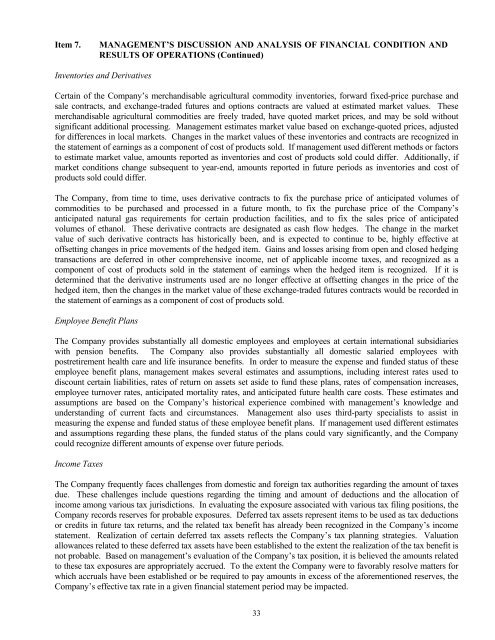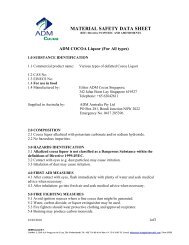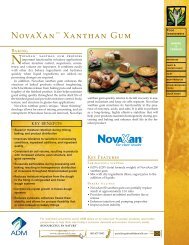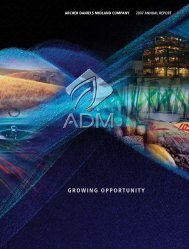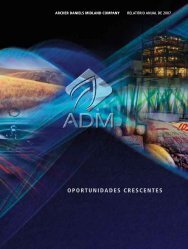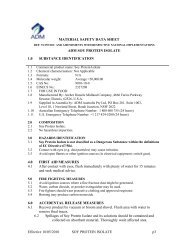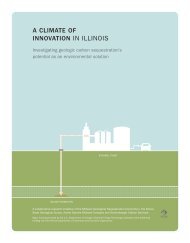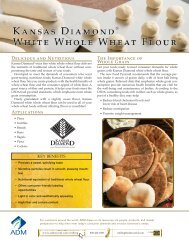German - ADM
German - ADM
German - ADM
- No tags were found...
You also want an ePaper? Increase the reach of your titles
YUMPU automatically turns print PDFs into web optimized ePapers that Google loves.
Item 7.MANAGEMENT’S DISCUSSION AND ANALYSIS OF FINANCIAL CONDITION ANDRESULTS OF OPERATIONS (Continued)Inventories and DerivativesCertain of the Company’s merchandisable agricultural commodity inventories, forward fixed-price purchase andsale contracts, and exchange-traded futures and options contracts are valued at estimated market values. Thesemerchandisable agricultural commodities are freely traded, have quoted market prices, and may be sold withoutsignificant additional processing. Management estimates market value based on exchange-quoted prices, adjustedfor differences in local markets. Changes in the market values of these inventories and contracts are recognized inthe statement of earnings as a component of cost of products sold. If management used different methods or factorsto estimate market value, amounts reported as inventories and cost of products sold could differ. Additionally, ifmarket conditions change subsequent to year-end, amounts reported in future periods as inventories and cost ofproducts sold could differ.The Company, from time to time, uses derivative contracts to fix the purchase price of anticipated volumes ofcommodities to be purchased and processed in a future month, to fix the purchase price of the Company’santicipated natural gas requirements for certain production facilities, and to fix the sales price of anticipatedvolumes of ethanol. These derivative contracts are designated as cash flow hedges. The change in the marketvalue of such derivative contracts has historically been, and is expected to continue to be, highly effective atoffsetting changes in price movements of the hedged item. Gains and losses arising from open and closed hedgingtransactions are deferred in other comprehensive income, net of applicable income taxes, and recognized as acomponent of cost of products sold in the statement of earnings when the hedged item is recognized. If it isdetermined that the derivative instruments used are no longer effective at offsetting changes in the price of thehedged item, then the changes in the market value of these exchange-traded futures contracts would be recorded inthe statement of earnings as a component of cost of products sold.Employee Benefit PlansThe Company provides substantially all domestic employees and employees at certain international subsidiarieswith pension benefits. The Company also provides substantially all domestic salaried employees withpostretirement health care and life insurance benefits. In order to measure the expense and funded status of theseemployee benefit plans, management makes several estimates and assumptions, including interest rates used todiscount certain liabilities, rates of return on assets set aside to fund these plans, rates of compensation increases,employee turnover rates, anticipated mortality rates, and anticipated future health care costs. These estimates andassumptions are based on the Company’s historical experience combined with management’s knowledge andunderstanding of current facts and circumstances. Management also uses third-party specialists to assist inmeasuring the expense and funded status of these employee benefit plans. If management used different estimatesand assumptions regarding these plans, the funded status of the plans could vary significantly, and the Companycould recognize different amounts of expense over future periods.Income TaxesThe Company frequently faces challenges from domestic and foreign tax authorities regarding the amount of taxesdue. These challenges include questions regarding the timing and amount of deductions and the allocation ofincome among various tax jurisdictions. In evaluating the exposure associated with various tax filing positions, theCompany records reserves for probable exposures. Deferred tax assets represent items to be used as tax deductionsor credits in future tax returns, and the related tax benefit has already been recognized in the Company’s incomestatement. Realization of certain deferred tax assets reflects the Company’s tax planning strategies. Valuationallowances related to these deferred tax assets have been established to the extent the realization of the tax benefit isnot probable. Based on management’s evaluation of the Company’s tax position, it is believed the amounts relatedto these tax exposures are appropriately accrued. To the extent the Company were to favorably resolve matters forwhich accruals have been established or be required to pay amounts in excess of the aforementioned reserves, theCompany’s effective tax rate in a given financial statement period may be impacted.33


